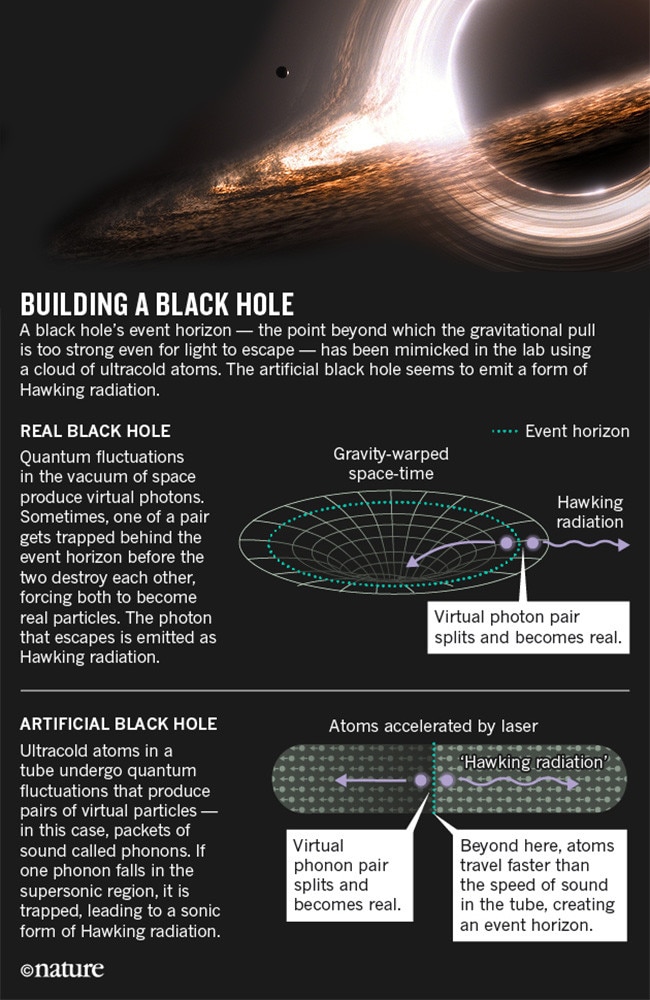An artificial black hole adds substance to Stephen Hawking’s greatest idea
STEPHEN Hawking may have got one of science’s biggest mysteries right. It turns out black holes may not be so black after all.

STEPHEN Hawking, it appears, may have got one of science’s biggest mysteries right. An artificial black hole has been built in a laboratory. Turns out it may not be so black after all.
Science journal Nature reports a physicist at the Technion-Israel Institute of Technology in Haifa claims to have successfully mimicked the effect of a black hole’s ‘event horizon’, the point at which gravity becomes so intense that not even light can escape its pull.
It’s a concept that has wracked physics ever since.
Where does all the ‘stuff’ pulled into a black hole go? How can you maintain the fundamental balances the laws of the universe demand?
Theoretical physicist Steven Hawking first put forward his seminal idea in the 1970s. He argued that black holes actually emit radiation — causing them to gradually shrink and ultimately disappear.
But how can this be proven?
It’s not as though you can create one in your lab.
Well, Jeff Steinhauer says you can.
SOMETHING FROM NOTHING
Quantum theory — the science of the strange small strands of energy that combine to form the building blocks of atoms — does not allow ‘nothing’ to exist. There is no void.
Even the most distant corner of deep space must have something in it.
And that something is created by ‘blips’ at the quantum level which create pairs of photons to bubble into existence before immediately destroying each other.
RELATED: Does time flow backwards on the other side of a black hole?
Hawking’s idea is that such bubbling of pairs of photons at a black hole’s event horizon could prevent some from selfdestructing. One photon would be pulled into the black hole, while the other escaped.
If real, this could be detected as a very faint radiation. Hawking radiation.

HOW TO TAME A BLACK HOLE
Science has been seeking a way to accurately emulate a black hole’s event horizon for decades.
The idea is simple enough: It’s the same as the point in a water fall where a swimmer’s strength matches the pull of the water.
But things get substantially more complicated at the atomic level. Recreating those conditions have so far been limited to computer simulation.
Replication and direct observation is something science has so far failed to achieve.
Steinhauer, however, says he’s finally nailed it.
Steinhauer says he recreated the conditions of a black hole’s event horizon by manipulating the way sound travels through a cloud of ultra-cold atoms.
EXPLORE MORE: A mysterious ‘great attractor’ is swallowing a galaxy
He suspended a cloud of rubidium atoms in a cigar-shaped container just a few millimetres long. These were then cooled to a point barely a fraction above absolute zero.
In this extreme cold state, the atoms’ quantum characteristics changed. Sound travelling through the condensate could move at just half a millimetre per second.
He then created an ‘acoustic event horizon’ by accelerating the atom cloud at the same speed in the opposite direction. It’s a point from which no sound should escape.
Steinhauser says some did.
He reportedly observed ‘packets’ of sound — similar to Hawking’s photon pairs — being pulled apart at the acoustic event horizon. This ‘radiation’ could be detected as a form of audio static.
SCIENCE KICKS IN
Academic reaction to the study is so far mixed, Nature reports.
Physicists agree the research is groundbreaking. Most, however, are reluctant to agree that this is in itself proof of Hawking’s controversial black hole ideas.
Steinhauser’s methodology must be being carefully examined. And his experiment will need to be recreated and retested many times before judgment is passed.
“This experiment, if all statements hold, is really amazing,” says Silke Weinfurtner, a theoretical and experimental physicist at the University of Nottingham, UK. “It doesn’t prove that Hawking radiation exists around astrophysical black holes.”




